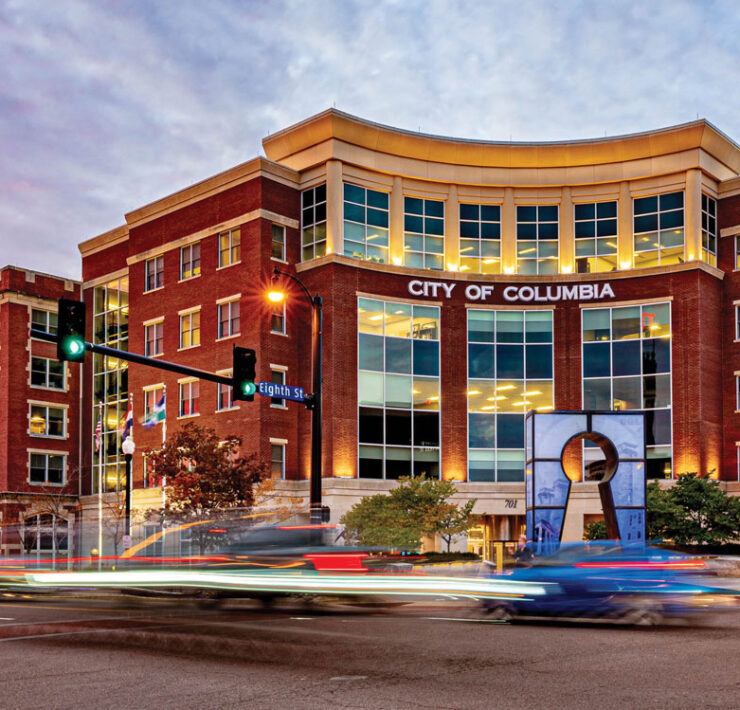Counting Cars: A look at road fees
Mayor Bob McDavid wasn’t convinced.
In an early August City Council meeting, the council was set to approve ballot language asking voters if the city should raise its road maintenance development fees associated with new construction projects.
McDavid had a 180-page report on the fee model in front of him but still was unsure the city had done its research.
“I don’t think we have any analysis on what we’re planning to do,” McDavid said. “What we don’t know is are we forcing housing into the county? Price matters, right? I think we all agree to that.”
Sixth Ward Councilwoman Barbara Hoppe began to speak.
“We have a lot of information in there,” Hoppe said as McDavid responded. “And probably what we need to do is have it in charts.”
Managing growth
Columbia has grown rapidly in recent years. Developments sprawl further into the city’s southern and western limits, and thousands of beds of student housing and luxury apartments have gone up downtown. Population grew 5.9 percent between April 2010 and July 2013, a full 5 percent ahead of the statewide rate. City Council members are the gatekeepers to new development proposals, and right now they aren’t letting anything through.
Growing pains accompany Columbia’s recent development boon. Rapid downtown construction has outpaced the capacity of the city’s ailing infrastructure. There’s a moratorium on new downtown development until the sewer lines and electric grid can be improved. Development fees, which the city levies against developers to create roads, are one source of capital for a city government stretched thin by growth. The City Council and city staff are exploring ways to raise the fees for the first time since 2009, but members remain divided on how to generate more revenue without scaring away new developers.
Developers in Columbia, whether they’re constructing a modest single-family home or a massive shopping complex, pay a 50-cent fee per square foot of space. The fee goes toward road construction, though other fees fund stormwater, permits and water and sewer expenses. The 50-cent development fee was gradually increased from 10 cents after a 2005 vote. This fall, voters will be asked to approve a different fee model, one that would substantially raise rates but would bring in an estimated $3.5 million a year.
Voters will weigh a switch to a trip generation fee system, where developers pay based on the car traffic the new development generates. The new system would raise development fees to $1 per square foot on residential spaces. Nonresidential developers would pay $1.50 or $2 per square foot depending on traffic levels. Generating three or fewer car rides per 1,000 square feet during the 4 to 6 p.m. rush hour is considered low impact, for the $1.50 fee. More than three trips is high impact and would cost $2 per square foot. The impact levels are based on national standards developed by the Institute of Transportation Engineers.
Council members have been working on the trip generation fee model for months, but they still disagree on whether the new model is the right direction for the city. Approving the fees for the ballot took up well over an hour of the City Council’s time. Residents who spoke at the meeting all supported the fees and asked the council to consider making them higher.
By 11:30 p.m., McDavid smiled as he asked council members to try to keep further discussion of the fees brief. His request was more jovial than authoritarian. Voting didn’t come until after midnight.
Third Ward Councilman Karl Skala is the model’s fiercest advocate, having supported it since city officials first considered the plan in 2004. Fourth Ward Councilman Ian Thomas and Hoppe also worked with Skala and City Manager Mike Matthes to develop a potential November ballot question on the model.
“If we don’t change this model, we’re not talking about a lot of money here,” Skala said. “You can’t really build much for $3.5 million, but it’s a step in the right direction.”
But McDavid came out firmly against the fees in a July work session regarding ballot issues, saying the council still had research to do.
“The work has not been done,” McDavid said in August. “I don’t see any analysis of the impact of what we’re intending to do.”
First Ward Councilwoman Ginny Chadwick also expressed concern that the new fees could discourage small businesses from building in town and called the model “broken” in a council meeting.
“I really think the trip generation model is going to affect the small local business owner who is being charged the same rate as a large corporate business that does generate that true amount of traffic,” Chadwick said.
At one point, Chadwick made a dig at Skala for prioritizing road improvements over sewer problems.
“Hey, hey!” Skala shouted.
McDavid rapped his gavel twice to restore order.
But for all of City Council’s disagreement, the issue is one that will ultimately come down to voters. The council voted 5-2 to put the issue on the November ballot.
Differing strategies
The development fee isn’t designed to completely cover the costs of building new roads, but it does cover a portion of the expenses. Thomas says that over the past decade, development fees brought in about $7.5 million, but city officials spent about $80 million in that period on “capacity expansion,” or building new roads to accommodate Columbia’s growth.
Skala says the fee proposal came down to compromising among city officials and that council members considered fees as high as $8 to $10 before eventually proposing fees of $2 to $4. The fees were ultimately cut again, though many council members and citizens felt they could be higher.
“If I were making amendments here, I would increase some of these charges,” Skala says. “We started at about $8 or $10 for some of the commercial development. With our best judgment, we recommended to City Council at $2, $3 and $4.”
In 2007, City Council commissioned MU professor emeritus Ben Londeree to study infrastructure financing models in 40 cities similar to Columbia. The numbers were updated in 2014. Although Columbia’s road fees increased 233 percent between 2007 and 2014, it still had the fifth-lowest fee rate. Columbia’s average $1,000 fee for a single-family home was below the $1,500 average of all studies cities.
The trip generation model’s proponents argue the new system would put Columbia’s fee revenues on par with other Midwest cities, even though none of the smaller Boone County cities collect road fees.
Council members focused particular attention on Lincoln, Nebraska, one of the 40 cities in the study. The city shares many similarities to Columbia. With 268,738 residents, it’s a bigger town, but like Columbia it houses its state’s flagship university and is growing at a faster rate than the state average. Unlike Columbia, it charges hefty road fees.
Lincoln began levying road construction impact fees based on trips generated in June 2003. Its fee schedule is more complicated than the one Columbia is proposing, with flat-rate charges for residential construction and a variable schedule for commercial, institutional, industrial and recreational space. A mini warehouse developer would pay 38 cents per square foot, while a bank developer would pay $7.09. New golf courses cost nearly $4,000 per hole. Hotels and motels are $895 per room.
Since introducing the fees, Lincoln has brought in more than $29 million and spent about $20 million expanding roads. Projects range from $2,000 road-use studies to $3 million three-lane road construction.
Seventeen of the 40 cities Londeree examined had road fees. Eleven of the 17 used a trip generation model. And faster-growing cities levied more infrastructure fees in general.
Boulder, Colorado, has a population of 103,166 and is home to the University of Colorado System’s main campus. Its infrastructure fees are 20 times more than Columbia’s, and the city has had a road fee in place since 1998. Its road fee is $2,170.50 for a single-family home, compared to the $1,000 a Columbia developer would pay to construct a 2,000-square-foot house. Duplex and mobile home developers pay about $1,608. Nonresidential developers pay $2.48 per square foot, no matter what they’re constructing.
The road fee covers about 4 percent of the transportation department’s $31 million budget.
Although the trip generation model going on the November model is different from Skala’s early proposals — even Columbia’s low-impact fees would have surpassed Boulder’s $2.48 nonresidential fee — he still says implementing the system will be a good first step toward keeping up with Columbia’s growth.
“Growth has tremendous benefits,” Skala says. “It also has tremendous costs, and we have never been prepared to pay those costs. My primary objective is to get the model changed and get use in along with size.”





